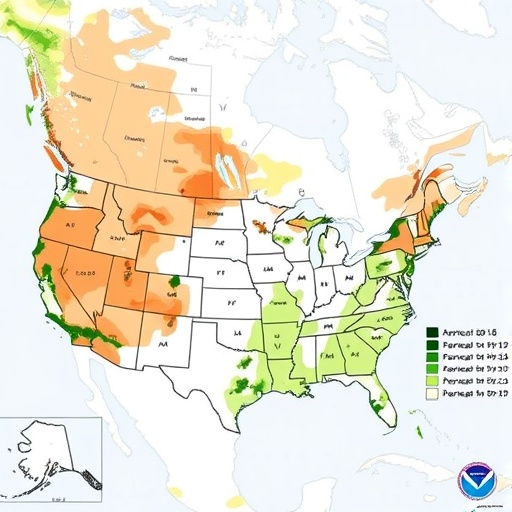A groundbreaking study utilizing data from the UK Biobank has revealed a critical environmental interplay influencing postmenopausal breast cancer risk. Researchers from the United States have uncovered compelling evidence that exposure to green environments may significantly mitigate the risks associated with air pollution, offering new hope for cancer prevention strategies within vulnerable populations. This study, recently published in the reputable journal PLOS One, dives deep into the complex synergistic effects of environmental factors on human health, highlighting the protective potential of greenness amid escalating urban pollution.
Air pollution remains one of the most pressing public health concerns globally, with a well-established link to various forms of cancer, including breast cancer. However, the novel aspect of the present research is its focus on how the presence of vegetation and green spaces can alter this risk, particularly among postmenopausal women—a demographic known to be at heightened susceptibility to breast cancer. By harnessing the extensive UK Biobank dataset, which contains comprehensive health and environmental exposure information on hundreds of thousands of individuals, the study provides an unparalleled perspective on these interactions.
The methodology involved a rigorous statistical analysis correlating individuals’ exposure to fine particulate matter (PM2.5) and nitrogen dioxide (NO2), principal pollutants linked to carcinogenesis, with the density of green spaces surrounding their residences. The researchers employed advanced geospatial modeling techniques to quantify greenness levels using normalized difference vegetation index (NDVI) values derived from satellite imagery, offering precise and objective measurements that facilitated a robust evaluation of environmental influences on cancer risk.
Crucially, the findings demonstrated that women residing in areas characterized by higher greenness exhibited a notably attenuated association between air pollution exposure and breast cancer incidence. This moderation effect suggests an underlying biological or psychosocial mechanism through which green environments confer resilience or reduce carcinogenic processes triggered by polluted air. The study posits several hypotheses regarding these mechanisms, including improved immune function, reduced systemic inflammation, and decreased oxidative stress resulting from exposure to natural landscapes.
Beyond biological plausibility, the research acknowledges behavioral and socioeconomic factors potentially contributing to these outcomes. Access to green spaces is often linked to enhanced physical activity, reduced stress levels, and better mental health—all of which can influence cancer risk and progression. By integrating such multifaceted variables, the study underscores the importance of holistic environmental health perspectives when devising public health interventions targeting cancer prevention.
Furthermore, the researchers controlled for confounding variables such as age, body mass index (BMI), smoking status, and socioeconomic status, reinforcing the credibility of the observed interaction between greenness and air pollution. Their rigorous adjustment for these covariates addresses potential biases and strengthens the argument that greenery exposure independently modifies air pollution’s impact on breast cancer risk.
The implications of this study are far-reaching. Urban planners and public health policymakers should consider incorporating and preserving green spaces within densely populated areas to mitigate the deleterious effects of pollution. As air quality continues to worsen in many metropolitan centers worldwide due to industrialization and vehicular emissions, this research advocates for integrating environmental design with cancer prevention frameworks.
Additionally, the study calls for further research to elucidate the molecular pathways through which exposure to nature modulates cancer susceptibility in polluted contexts. Future investigations may include longitudinal biomarker assessments, mechanistic laboratory experiments, and intervention trials designed to test the protective efficacy of green spaces.
This evidence contributes to a growing body of literature emphasizing environmental determinants of health beyond traditional risk factors such as genetics and lifestyle. It advocates a paradigm shift toward recognizing the environment as a modifiable cancer risk factor, thereby highlighting the dual benefits of greenness for ecological sustainability and human health.
In conclusion, the interplay between greenness and air pollution presents a nuanced yet promising avenue for reducing breast cancer vulnerability, particularly among postmenopausal women. This study offers a crucial scientific foundation for leveraging natural environments in health promotion and disease prevention, aligning with broader efforts to foster healthier, more sustainable urban living conditions worldwide.
Such findings reinforce the urgency of environmental justice initiatives, ensuring equitable access to green spaces irrespective of socioeconomic status, as disparities in exposure may exacerbate health inequalities. Harnessing the protective power of greenness could translate into tangible reductions in cancer burden, improving quality of life for millions globally.
As researchers continue to unravel the complex environmental tapestry affecting cancer risk, studies like this one highlight the interconnectedness of ecological and human health. Their insights challenge us to rethink urban landscapes as vital components of preventive medicine, opening innovative pathways for combating the pervasive threat of cancer through nature-based solutions.
Subject of Research: Interaction of greenness and air pollution on postmenopausal breast cancer risk using UK Biobank data
Article Title: Greenness and its interaction with air pollution in relation to postmenopausal breast cancer risk in UK Biobank
News Publication Date: 12-Nov-2025
Web References: DOI link
Image Credits: Picas Joe, Pexels, CC0
Keywords: Air pollution, breast cancer, greenness, postmenopausal women, UK Biobank, environmental health, NDVI, urban green spaces, cancer prevention, particulate matter, nitrogen dioxide, environmental epidemiology
Tags: air pollution and healthcancer prevention strategiesenvironmental factors and cancerenvironmental health researchfine particulate matter and cancer riskgreener environments and breast cancer risknitrogen dioxide exposure and healthpostmenopausal breast cancer preventionprotective effects of green spacesUK Biobank data analysisurban pollution and healthvegetation impact on health outcomes





